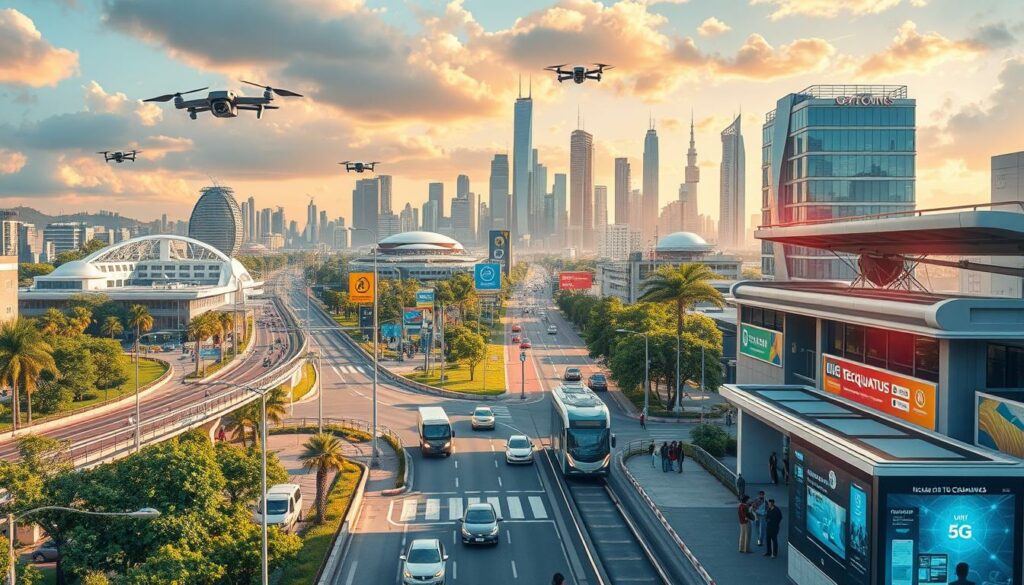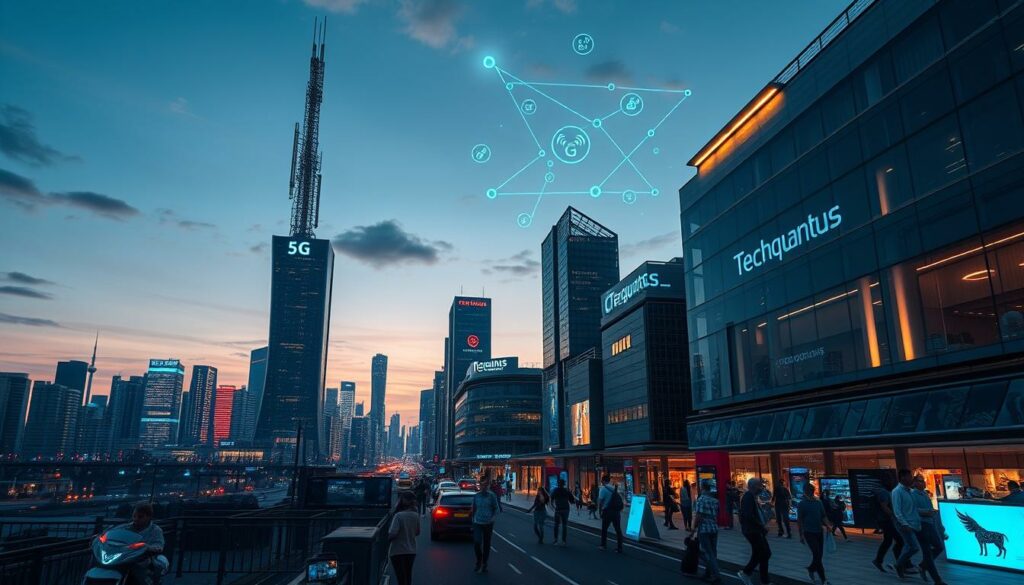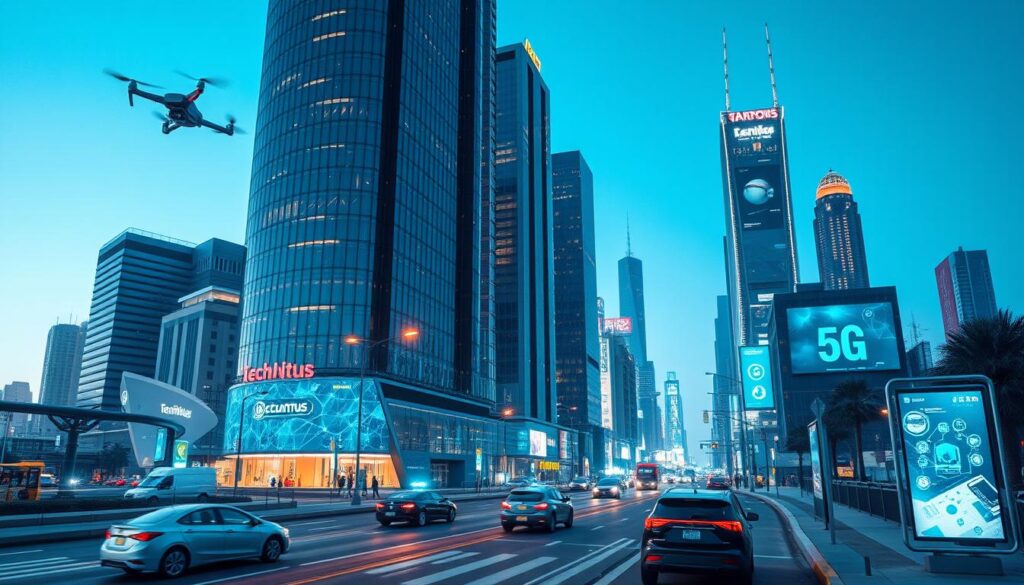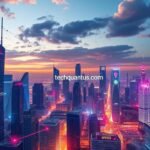Did you know that by 2030, over 50 billion devices will be connected worldwide? This shows how vital 5G and IoT are for smart cities. 5G’s fast speeds and low delays let cities use real-time data to automate many tasks. This makes services better for everyone living or visiting the city. But, making this work needs big upgrades in infrastructure at city and service provider levels.
5G and IoT bring real-time automation to cities. This means quick actions that make city life better. For example, it can help spot fraud or manage traffic better. As cities get more automated, we must also build a strong data infrastructure. This ensures the integration works well and solves problems fast. You can learn more about the challenges and solutions in this exclusive report.
We will look into how to use 5G and IoT for smart cities. We’ll cover their roles, challenges, and how they work in real life. This is not just about new tech. It’s about making city life better for everyone.
Key Takeaways
- The integration of 5G and IoT is crucial for the evolution of smart cities.
- Real-time data processing enables immediate urban automation actions.
- Infrastructure upgrades are essential to support advanced connectivity.
- 5G technology enhances communication between myriad devices.
- Effective strategies can lead to improved urban living experiences.
- Investing in real-time observability is necessary for system efficiency.
- Collaboration among stakeholders will drive successful implementations.
The Role of 5G in Smart Cities Development
5G technology is key to making smart cities better. It can handle lots of data fast and efficiently. This means cities can manage traffic, keep people safe, and monitor the environment better.
As more people need to be connected, the demand for 5G is growing. Experts predict a big increase in use, making cities better for everyone. This change will help many areas of life, making 5G crucial for smart city solutions.
Smart cities use 5G’s strong network to improve life. Faster data speeds and lower delays mean cities can manage services in real-time. For instance, traffic can move smoother and air quality can be monitored closely.
The partnership between Tech Data and Allied Telesis shows how 5G is innovating. They’re working on AI-driven networks that focus on security. This shows how 5G will make cities safer and more resilient.
- Traffic management: Leveraging 5G technology can streamline traffic flow.
- Public safety: Improved response times through efficient communication systems.
- Environmental monitoring: Real-time data collection on air and noise pollution.
5G is changing how cities work together. It’s making them smarter and more responsive. This tech is key for a better future in cities.
Explore more on the importanceof 5G and IoT integration
Understanding the Internet of Things (IoT)
The Internet of Things (IoT) is changing how devices talk to each other. It’s a network of devices that share and analyze data to make things work better. In cities, IoT helps manage resources and make life better for everyone.
Smart city tech uses IoT to solve big problems like traffic, energy use, waste, and safety. For example, IoT helps traffic flow better by using data from cars and traffic lights. This leads to less traffic and cleaner air for everyone.
Experts say IoT is getting more important in the market. The Industrial Wireless Sensor Networks (IWSNs) market is growing fast, with a Compound Annual Growth Rate (CAGR) of 7.00%. By 2022, it was worth about $4 billion, showing how fast IoT is being used in fields like energy and healthcare.
Big names like Honeywell are leading in IWSNs, showing a tough competition. They’re all pushing for new ideas and staying ahead. New tech like LoRaWAN is making IoT cheaper and easier to use, helping cities get smarter.
5G and IoT: Enhancing Urban Automation
The mix of 5G and IoT changes how smart cities work. It lets cities use real-time data to make smart choices. This leads to better use of resources and more efficient city management.
Think about how things like trash removal and public transport change with these techs. Devices talk to each other better, making things run smoother. This helps cities deal with their big challenges faster.
In cities, making quick decisions is key. 5G’s fast data handling cuts down on wait times. This is crucial for cities to manage their resources well.
With these techs, cities can try new things. For instance, connected devices can help manage traffic better. Also, they can make public safety systems work faster.
Looking into big data infrastructure shows how important it is for smart cities. IoT and edge computing together make cities smarter and more flexible.
| Feature | Impact on Urban Automation |
|---|---|
| Real-Time Data Analysis | Enables quick decision-making for city governance. |
| Reduced Latency | Improves response times in emergency situations. |
| Enhanced Connectivity | Facilitates communication between various IoT devices. |
| Data Security | Addresses challenges posed by cyber threats as cities become more connected. |
Using 5G IoT tech helps cities use automation fully. It’s making smart city features work better and better.
Key Smart City Technologies Enabled by 5G
5G brings new life to cities with advanced smart city tech. It offers fast speeds and low delays. This lets cities use many new solutions, making life better for people and work more efficient for governments.
The smart grid is one big win. It makes how we use and get energy better and greener. With 5G, cities can track how much energy we use, manage it better, and use more solar and wind power.
Intelligent traffic systems are another big step forward. Cars and roads talk to each other with 5G. This means traffic lights change faster and less traffic jams. It cuts down on travel time and pollution too.
Public safety gets a boost from 5G too. Emergency services can react faster and better. With high-definition videos from drones or phones, they can see what’s happening in real time. This helps them make quick, smart choices.
These changes mean cities can grow and stay strong. They become smarter and more connected. Knowing how 5G helps with these techs is key. It’s all about making cities better for everyone. For more on how eSIMs fit into this, check out this report on eSIM technologies.
Infrastructure Needs for Integrating 5G and IoT
For smart cities to use 5G and IoT well, they need strong infrastructure. Upgrades are key to keep up with tech progress and handle more data. Fast, reliable internet is crucial for many uses, making it a big focus for city planners and tech experts. With the Global 5G Processor Market expected to hit USD 36.1 Billion in 2023, it’s important to understand the changes needed.
Necessary Network Upgrades
Upgrading networks is complex and involves several steps:
- Installing new base station equipment.
- Boosting bandwidth to handle more data.
- Strengthening cybersecurity to protect IoT device info.
These upgrades are vital for smart cities to use 5G well. A strong network lets devices and services talk smoothly, making quick decisions possible.
Challenges with Current Infrastructure
There are big challenges with today’s infrastructure for IoT. Key issues include:
- Compatibility problems with old systems, causing delays.
- High upfront costs, which can be hard for cities.
- The need for standardizing different parts.
Overcoming these hurdles is key for cities to fully use 5G and IoT. As noted in recent reports, North America is leading in growth thanks to good rules and strong teamwork.
Real-World Applications of 5G and IoT in Smart Cities
5G and IoT are changing the game in smart cities. They bring new solutions for traffic and energy management. These technologies make cities better places to live.
Traffic Management Solutions
Smart traffic systems use real-time data to cut down on congestion and make roads safer. They connect cars with traffic lights and routes, making traffic move better. Algorithms look at traffic patterns to change signals and routes on the fly.
This means less waiting in traffic and fewer emissions from cars. It’s good for the environment and people.
Smart Energy Management Systems
IoT sensors and 5G networks are key in managing energy use. They watch how much energy is used and adjust the supply. This helps cities use energy better and support green efforts.
It leads to better use of resources and helps cities be greener. For more on AI in these technologies, check this resource.

Benefits of 5G and IoT Integration
5G and IoT together bring big benefits to cities, making them smarter and more efficient. They offer faster and more reliable connections. This means city services work better, making life easier for everyone.
Public safety gets a boost with real-time data from IoT devices. Emergency services can respond quicker and more effectively. This makes cities safer for everyone.
Using 5G and IoT also saves money. Cities use resources better, cutting down on energy and maintenance costs. This helps cities grow in a sustainable way, tackling challenges of urban growth.
Decisions in cities become smarter with data from IoT devices. This leads to better planning and a higher quality of life for people living there.
These technologies also help with the environment. Cities can track air quality, manage waste, and save water and energy. Smart grids and connected energy systems are key to improving urban efficiency and sustainability.
The Networking Products market is growing fast, expected to hit about $40 billion in the U.S. by 2023. This growth means cities have more chances to use these technologies. It shows how business and smart city benefits can work together.
For more info on the Networking Products market, check out industry reports. They cover trends and chances for growth. Learn more here.
Steps to Implement 5G and IoT Solutions
To make your city smarter, it’s key to work with different groups. Finding the right people to help means everyone knows what to do. This includes local governments, tech companies, and community groups. Working together can make projects that use new tech better for city life.
Identifying Stakeholders and Partnerships
It’s important to talk to many people for your smart city plans. Good IoT partnerships might include:
- Local government entities to ensure compliance with regulations.
- Technology firms specializing in 5G infrastructure to facilitate seamless connectivity.
- Educational institutions for research collaboration and innovation.
- Community organizations to address local needs and gain public support.
These partnerships bring together the resources and knowledge needed for success.
Conducting Feasibility Studies
After finding the right people, you need to check if your ideas work. This means looking at what the community needs and if your plans will help. Important things to think about include:
- Technical needs for 5G, like what’s missing in the infrastructure.
- Money matters to figure out costs and how to manage them.
- Looking at the market to see if people will use the tech and get involved.
Doing deep studies helps make sure your city plans meet what people want. It also increases the chance of getting the money and support needed.

Conclusion
The blend of 5G and IoT is key to the future of smart cities. These technologies bring new ways to improve city life, making it better for everyone. They help manage traffic and make energy use more efficient, opening up a world of endless possibilities.
Creating smart cities needs a team effort from governments, tech firms, and local communities. Working together helps bring new ideas to life. This teamwork is vital for making cities strong and sustainable. It’s important to support these efforts and push for the investments needed for progress.
With new digital threats always coming up, keeping cities safe is a top priority. Using the latest in cybersecurity, like cybersecurity innovations, is crucial. Staying updated and flexible will help your city succeed in a connected world.
FAQ
What is the significance of 5G in smart city development?
5G technology is key for smart cities because it offers fast internet and quick data exchange. This helps with traffic, safety, and monitoring the environment. It makes cities run better and improves life for everyone.
How does the Internet of Things (IoT) contribute to smart cities?
IoT connects devices to share data, which is crucial for smart cities. It helps manage resources better and makes cities work more efficiently. IoT is important for improving transport and energy use, making cities more connected.
What are some real-world applications of 5G and IoT in smart cities?
In real life, 5G and IoT help manage traffic by using real-time data. They also make energy use smarter by monitoring it closely. This helps cities use energy better and be more sustainable.
What infrastructure changes are needed to integrate 5G and IoT solutions?
Cities need to upgrade their networks with new equipment and increase bandwidth. They also must strengthen cybersecurity to handle lots of data. It’s important to make sure these new technologies work well with what’s already there.
What benefits can cities expect from integrating 5G and IoT?
Cities gain more efficiency, save money, and get safer with 5G and IoT. People’s lives get better, and cities can tackle big issues like the environment and growth with data.
How can stakeholders effectively implement 5G and IoT solutions in smart cities?
To make it work, everyone involved must work together. This includes local governments, tech companies, and community groups. It’s important to study if a solution will work and if it meets the community’s needs.
Source Links
- https://www.rtinsights.com/why-real-time-businesses-need-flight-data-recorders/
- https://www.mdpi.com/2079-9292/13/17/3562
- https://www.clubitc.ro/2024/09/09/tech-data-si-allied-telesis-vor-revolutiona-solutiile-tehnologice-pentru-cio/
- https://www.openpr.com/news/3648997/exclusive-research-report-on-esim-for-digital-nomads-market
- https://www.openpr.com/news/3648666/global-industrial-wireless-sensor-networks-market-size-share
- https://www.linkedin.com/pulse/oem-commercial-vehicle-telematics-market-size-share-wvshf
- https://www.bisinfotech.com/godawari-electric-motors-unveils-eblu-cety-on-world-ev-day/
- https://www.bisinfotech.com/5-electric-scooter-revolutionizing-urban-mobility-in-india-on-world-ev-day/
- https://www.openpr.com/news/3648786/edge-computing-market-forecast-emerging-trends-and-growth
- https://lafuncion.mx/uncategorised/dielectric-filter-for-5g-base-station-market-by-sources-analysis-share-trends-size-forecast-from-2024-2032/339135/
- https://www.bisinfotech.com/reducing-co2-and-carbon-emissions-strategies-for-a-sustainable-future/
- https://blog.libero.it/wp/dhama/2024/09/09/5g-processor-market-dynamics-and-key-players-forecast-and-growth-trends-through-2029/
- https://www.communicationstoday.co.in/mobily-signs-major-six-year-deal-impacting-over-5-of-annual-revenue/
- https://timestech.in/employee-benefits-and-cybersecurity-insurance-how-ai-is-transforming-risk-assessment-and-coverage/
- https://medium.com/@sb.prem17/top-technology-trends-for-2024-and-2025-8c22dd6e7e8f
- https://www.openpr.com/news/3648668/networking-products-market-investment-opportunities
- https://emag.directindustry.com/2024/09/09/nis-2-how-it-may-affect-your-business-and-how-to-prepare/
- https://www.trendforce.com/news/2024/09/09/news-intel-reportedly-outsources-all-sub-3nm-process-production-to-tsmc/
- https://cxotoday.com/specials/pidf-and-last-mile-acceptance-history-and-what-are-the-opportunities/
- My Guide to Understanding Data Centre Architecture: Core Components Every IT Pro Should Know
- Wazuh Home Network Setup: A Step-by-Step Guide
- Quantum Computers Decrypting Blockchain: The Risks and Implications
- Wazuh: Enterprise-Grade Security for Your Business
- Wazuh for Beginners: A Comprehensive Guide




